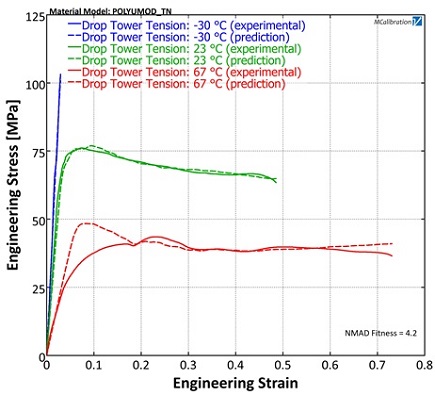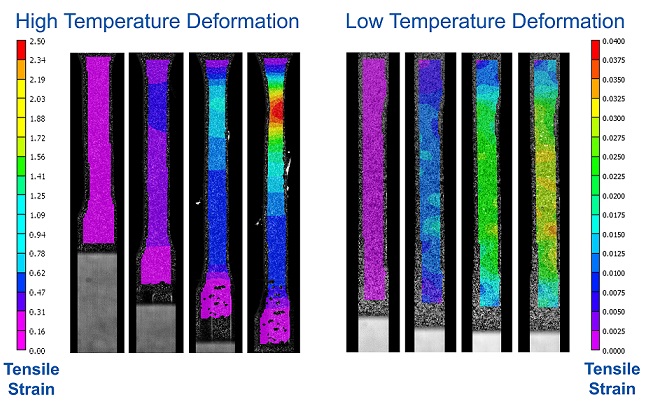Technical Challenge
Modern materials exhibit time- and temperature-dependent effects that must be taken into account during product development and design. Products may be over-designed leading to higher costs or may fail during normal use scenarios if only room temperature properties are considered.
Materials exhibit changes in initial modulus, failure stress and strain, and may undergo ductile-to-brittle transitions. Good design practice therefore includes determining high rate properties and calibrating material models at service temperatures.
High speed video of the high temperature (left) and low temperature (right) tests recorded at 40,000 and 50,000 frames per second, respectively. Classic strain measurement techniques are not applicable due to the high strain-rate (75/s). Instead, to measure strain, specimens have been painted with a speckle pattern and strain is calculated post-test using Digital Image Correlation (DIC) software. The low temperature test is significantly shorter than the high temperature video because of the quick specimen fracture due to the temperature. The low temperature video also shows the paint flaking off of the specimen during fracture.
Veryst Solution
Veryst has extensive experience testing complex materials at low and high temperatures (-100ºC to 300ºC) and calibrating material models to test data. In this example, we tested nylon on our custom drop tower at -30ºC, 23ºC, and 67ºC. The material exhibited large changes in behavior in this temperature range. Young’s Modulus changed by ~30%, yield stress doubled at high temperature, and a transition to brittle failure occurred at -30ºC.
Additionally, we calibrated the data to the Three Network (TN) model, available through the PolyUMod® material library, developed by Veryst and now available through PolymerFEM.com. The model accurately captures the strain-rate and temperature dependence of the material.
The resulting model can be used in commercial finite element packages (Abaqus, ANSYS, COMSOL Multiphysics, LS-DYNA, or MSC.Marc).
Drop tower test data at 75/s at -30ºC, 23ºC, and 67ºC and material calibration with Veryst Engineering’s Three Network model. The high temperature data shows a lower elastic modulus and the material yields earlier compared to room temperature. The low temperature test shows no plastic deformation and brittle fracture. Noise in the data is typical of high rate tests due to dynamic effects
DIC images showing tensile strain fields for high temperature and low temperature specimens. The high temperature images (left) show significantly higher strains and strain localization, while the low temperature images (right) show no strain localization

